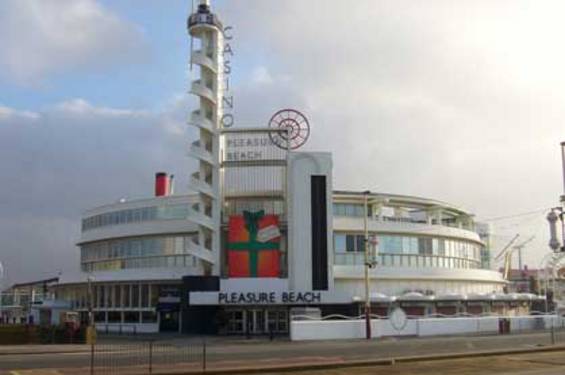This website uses cookies
This website uses cookies to enable it to function properly and to analyse how the website is used. Please click 'Close' to accept and continue using the website.



January 2007 - Joseph Emberton’s Blackpool Pleasure Beach
Architect: Joseph Emberton
Text and pictures by Ted Lightbown
Blackpool’s Pleasure Beach developed at the southern end of the resort from an informal fairground at the beginning of the twentieth century. It relied from the outset upon American rides and was soon advertising itself as England’s greatest American amusement park. In 1931, while on a visit to Philadelphia, the Pleasure Beach’s new managing director Leonard Thompson saw parks themed in the modernist style and thought the style might suit the Pleasure Beach.
He initially employed a Philadelphia architect, Edward Schoeppe, to design a new frontage to the park. However, in 1933 Thompson brought in Joseph Emberton to give the Pleasure Beach a unified image. By the end of the decade there was not a corner of the park that had not been transformed in the Emberton style. Old rides that did survive were at the very least given modernist kiosks and signage. Many of his designs had the spontaneity of exhibition buildings of the period, but, similarly lacked durability.
Emberton’s work for the Pleasure Beach culminated in a replacement for the wedding-cake-like Casino building of 1913. Despite the name, neither this building nor its replacement were ever intended or used for gambling. Emberton designed it from 1937 with local man Halstead Best as associate architect.
Although a very different building, the Casino inevitably draws comparison with the De la Warr Pavilion, but whereas the latter stands in splendid isolation on Bexhill’s sea front, the Casino has to compete with what is perhaps the most visually intensive backdrop in the country. Its main staircase, however, owes something to Gropius’s model factory for the 1914 Werkbund Exhibition at Cologne.
The building was opened in May 1939 by Baron Stamp. Although it attracted articles in the leading architectural magazines, people then had other preoccupations. Little over a year later, Stamp and his wife were killed when their house in Kent was bombed.
Emberton continued to design for the Pleasure Beach up to his death in 1956, after which Jack Ratcliffe, who had been involved in the Festival of Britain, was brought in. Following Leonard Thompson’s death in 1976, Keith Ingham was engaged to make extensive alterations to the Casino, when its name altered to the Wonderful World Building! Its concrete exterior was painted for the first time, reflective glass put in and Mickey Mouse-style red kiosks placed around the base. An external glass lift was added and the park’s monorail re-routed around the circular building. Inside, the central kitchens and service areas were removed and most of the public rooms were altered, losing their 1930s atmosphere. The main exceptions were the managing director’s office and compact flat, which still have built-in furniture by Emberton.
In recent years the building has reverted to its original name and only last year over half a million pounds was spent by the company on renovating its exterior. Clutter has been removed, blown reinforced concrete replaced and even Ingham’s kiosks have been toned down by painting them white. Sadly, the opportunity has not been taken to remove a redundant box office from the base of the curtain-glass main stairwell, while the adjoining Passage Del Terror is a terrible intrusion. But Emberton’s original design is strong enough to take these indignities. It is still a well-utilised building and the recent refurbishment only emphasises the Pleasure Beach’s commitment to it.
Look for past Buildings of the Month by entering the name of an individual building or architect or browsing the drop down list.

Become a C20 member today and help save our modern design heritage.